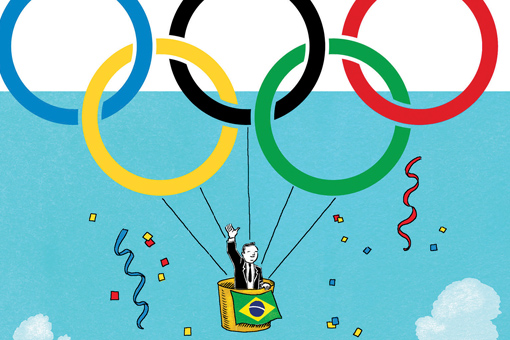In the next two years, Brazil will host the three largest mega sports events in the world: the 2014 FIFA World Cup this summer, and then the Summer Olympics and Paralympics in Rio in 2016. Other nations in the Americas and across the globe will be watching to see if Brazil’s hosting duties lead to broad-based, lasting growth, or are merely an expensive distraction. While history provides examples of both scenarios, hosting such megaevents can provide lasting and transformative value, including to developing nations.
Megaevents can accelerate the process of planning for and executing much-needed public investment, while the host countries or cities can rebrand themselves as safe for investment and trade, and as a destination for tourism. For democratic governments, the construction blitz around megaevents can cut through political deadlock, representing the best available chance to quickly bring about focused and necessary change.
The ability to develop infrastructure that can improve the quality of life, health and economic strength of the host nation is key. Hosts with plans focusing on self-improvement, investment and the enlargement of existing assets tend to fare better than countries that simply build competition venues.
For a vast country like Brazil, the planned improvement in airports and highways can be a long-lasting legacy of the upcoming events. The scheduled $9 billion investment in reducing crowding and increasing passenger and freight capacity in Rio de Janeiro and Belo Horizonte can better connect these cities to global markets.
Mega sports events also provide an opportunity to quickly change global perceptions of the host.
For lesser-known destinations, hosting such an event can draw between 500,000 and 3,000,000 visitors from all over the world, including decision makers from some of the most significant brands and business entities on the planet.
For more visited places, the attention of the world, manifested both in personal visits and through thousands of hours of broadcast and digital coverage, can help recast the image of the host as modern and globally relevant.
For South Africa, hosting the 2010 World Cup—the first in Africa—meant demonstrating that the post-apartheid nation was safe to visit, and showcasing its growing economy.
More recently in Sochi, Russian oil and mineral wealth was harnessed to transform the country’s southern region into a global sports and recreation destination. The jury is still out on the ultimate success of President Vladimir Putin’s Sochi strategy, but the positive feedback on the newly constructed Olympic venues—connected to Sochi by high-speed rail built for the games—will definitely improve the region’s image.
The exposure also links the host city and country’s markets, suppliers and customers with potential international trading partners and investors.
This is especially true of Brazil, where thousands of global decision makers will have a personal exposure to its growing economy that they might not have had otherwise. That is one reason why megaevents have resulted in an increase in the number of publicly traded companies in the host nation—sometimes a significant one—outperforming global markets that year. Another plus: the extraordinary number of contracts host nation businesses are suddenly competitive for after the event.
To reap the benefits of these events, developing countries would do well to learn from successful models of the past. Barcelona, the host of the 1992 Summer Olympic Games, is probably the first great success story of building through hosting. Prior to becoming host, the Mediterranean coastal city was shaking off decades of oppression and economic underdevelopment under fascist rule.
In preparing for the Games, Barcelona spent comparatively little on its facilities and much more on improving the city and its port, expanding the transportation system, creating new attractive housing, and showcasing its culture. Removing an iron border of factories and rail yards, Barcelona created miles of beach and waterfront promenades. Repurposing existing facilities, the planners framed athletic events with images of the city’s rich history of the arts. After two weeks of hosting an extraordinary fiesta during the Summer Games, Las Ramblas had become synonymous with the great avenues of the world.
Los Angeles, which perhaps single-handedly rescued the Olympic movement as the only bidder for the 1984 Summer Games, used a similar approach. The city turned an unprecedented $232 million surplus through shrewdly controlling costs and integrating private sponsorship of events and venues.
The lesson for all nations, whether developing or developed, is that stadiums, pools and bicycle tracks matter for sports fans—but airports, transportation, conference facilities, and beautification matter far more to residents and future visitors.
The real test, though, is whether host nations can sustain the momentum after the crowds have gone home. After the Summer Games, Barcelona continued the process of improvement and reinvestment, making it one of the world’s top tourist destinations over the succeeding two decades.
A new airport, cruise and freight ship terminals, and a fast rail connection to Paris have all followed. It is now preparing a bid for the 2022 Winter Olympics that would connect it with winter sports venues in the Pyrenees and cement Barcelona as the preferred port of entry to southern and central France and northern Italy.
This, more than anything, separates Barcelona from Athens, widely acknowledged as an Olympic failure: the will and ability to continue building on the momentum created by hosting a megaevent.
Whether Brazil 2014 or Rio 2016 can realize a lasting legacy from its turn on the global sports stage remains to be seen. But the transformative economic and social impact that well-planned and executed sports events can have on a city, a country and a people should not be understated.



